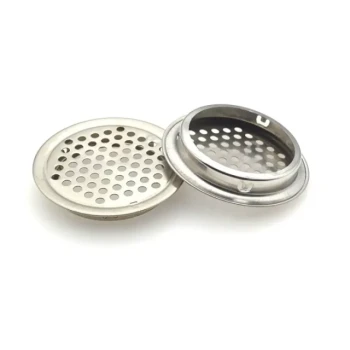No, a metal cover is not strictly necessary for the top of a beehive. Its primary function is not for the bees, but for the equipment itself. The metal acts as a durable shield, protecting the underlying wooden cover from the damaging effects of sun, rain, and snow, which significantly extends its operational life.
The choice to use a metal hive cover is not about absolute necessity, but about long-term durability and maintenance. While a wooden top can function, a metal-clad top is a practical investment in the longevity of your equipment.

The Core Function of the Hive Top
A hive's outer cover is its first and most important line of defense against the outside world. Its performance directly impacts the health and stability of the colony within.
Protection from Weather
The most obvious role of the outer cover is to keep the elements out. It must effectively shed rain and snow to prevent moisture from entering the hive cavity.
Maintaining a Stable Environment
A dry hive is crucial. Water leaks can lead to chilled brood, spoiled honey stores, and the growth of mold and fungus, all of which can be catastrophic for a colony.
Securing the Hive
The outer cover provides weight and security, ensuring the inner cover and the rest of the hive components remain sealed and protected from wind or pests.
Why Metal is the Industry Standard
While not essential, metal cladding became the standard for hive tops for several practical and compelling reasons. It solves the inherent weaknesses of wood as a long-term roofing material.
Superior Water Resistance
Wood is porous and will absorb water, leading to rot, warping, and decay over time. A galvanized steel or aluminum shell creates an impermeable barrier, preventing any moisture from reaching the wood.
Defense Against Sun and UV Damage
Constant exposure to the sun's UV rays dries out wood, causing it to become brittle and crack. A metal cover reflects this radiation, preserving the integrity of the wooden structure underneath.
Dramatically Increased Lifespan
A well-maintained wooden top might last a few seasons. A metal-clad top, by contrast, can easily last for a decade or more with minimal care, making it a far more reliable and cost-effective solution in the long run.
The Trade-offs of an All-Wood Top
Opting for a hive top without a metal cover is a valid choice, but it requires a clear understanding of the compromises involved. You are trading a lower upfront cost for a significantly higher maintenance burden.
The Constant Need for Sealing
An exposed wooden top is not a "set it and forget it" piece of equipment. It must be diligently protected with multiple coats of high-quality, non-toxic exterior paint.
Frequent Repainting is Required
This paint barrier is not permanent. It will peel, crack, and wear down over time due to weather exposure. You must inspect these tops regularly and be prepared to sand and repaint them every one to two years to prevent water infiltration.
Inevitable Water Damage
Even with the best care, water will eventually find its way into the wood, especially at the joints. Once rot begins, the structural integrity is compromised, and the top will need to be replaced to protect the colony.
Making the Right Choice for Your Goal
Your decision should be based on how you balance cost, convenience, and long-term reliability in your beekeeping operation.
- If your primary focus is maximum durability and minimal maintenance: A standard metal-clad telescoping outer cover is the most effective and reliable choice.
- If your primary focus is lowering initial costs or a DIY approach: An all-wood cover is feasible, but only if you commit to a strict and consistent schedule of sealing and repainting to protect it from the elements.
Ultimately, protecting your hive's cover is not an option, but choosing the best method for your needs is key to successful beekeeping.
Summary Table:
| Feature | Metal-Clad Cover | All-Wood Cover |
|---|---|---|
| Lifespan | 10+ years | 1-2 years (requires repainting) |
| Weather Protection | Excellent (impermeable) | Good (requires diligent sealing) |
| Maintenance | Minimal | High (frequent repainting needed) |
| UV Resistance | Excellent (reflects rays) | Poor (wood can crack) |
| Best For | Long-term reliability, minimal upkeep | Lower initial cost, DIY projects |
Protect your investment and simplify your beekeeping operations with durable, wholesale-priced equipment from HONESTBEE.
As a trusted supplier to commercial apiaries and distributors, we understand the critical need for reliable, long-lasting hive components that stand up to the elements. Our metal-clad telescoping covers are engineered for maximum durability and minimal maintenance, allowing you to focus on your bees, not your equipment.
Ready to equip your operation with gear built to last? Contact HONESTBEE today to discuss your wholesale needs and discover how our beekeeping supplies can enhance your productivity and profitability.
Visual Guide

Related Products
- Telescopic Beehive Outer Cover Lid Roof with Galvanised Sheeting for Langstroth Hive and Beehive Outer Cover
- Professional Insulated Winter Hive Wrap for Beekeeping
- Long Langstroth Style Horizontal Top Bar Hive for Wholesale
- HONESTBEE Professional Long Handled Hive Tool with Precision Cutting Blade
- Inner Beehive Cover for Beekeeping Bee Hive Inner Cover
People Also Ask
- Can bees enter from both sides of the outer cover? Master Seasonal Hive Management
- What are the two primary lid styles for Langstroth style beehives? Choose the Right Protection for Your Hives
- What maintenance is recommended for the Langstroth hive roof? Protect Your Hive with Natural Tung Oil
- What is a telescoping outer cover and what are its advantages? Maximize Hive Protection in Harsh Climates
- What is the function of the top cover in a Langstroth hive? Master Hive Protection & Climate Control



















